A Simplified Representation of Pressure Flow from Surface Slopes in Urban Sewer Systems
Abstract
1. Introduction
2. Materials and Methods
2.1. Study Area
2.2. Pressure Flow Simulation
2.2.1. SWMM
2.2.2. Rainfall Scenarios
2.2.3. Runoff Generation
2.2.4. Flood Volume
2.3. Pressure Flow Representation
2.3.1. Drainage Ratio
2.3.2. Correlation Analysis with Influential Factors
2.3.3. Regression Model
2.4. Flood Volume Adjustment
3. Results
3.1. The Effect of Pressure Flow
3.2. Significant Factors Affecting Pressure Flow
3.3. Estimate of Drainage Ratio under Pressure Flow
3.4. Flood Volume under Pressure Flow
4. Discussions
4.1. Representation of Pressure Flow
4.2. Applications
5. Summary and Remark
Author Contributions
Funding
Acknowledgments
Conflicts of Interest
References
- University of Maryland, Center for Disaster Resilience, and Texas A&M University, Galveston Campus, Center for Texas Beaches and Shores. The Growing Threat of Urban Flooding: A National Challenge; A. James Clark School of Engineering: College Park, MD, USA, 2018. [Google Scholar]
- Abhas, K.J.; Robin, B.; Jessica, L. Cities and Flooding: A Guide to Integrated Urban Flood Risk Management for the 21st Century; World Bank Group: Washington, DC, USA, 2012. [Google Scholar]
- Rubinato, M.; Nichols, A.; Peng, Y.; Zhang, J.; Lashford, C.; Cai, Y.; Lin, P.; Tait, S. Urban and river flooding: Comparison of flood risk management approaches in the UK and China and an assessment of future knowledge needs. Water Sci. Eng. 2019, 12, 274–283. [Google Scholar] [CrossRef]
- Apel, H.; Aronica, G.T.; Kreibich, H.; Thieken, A.H. Flood risk analyses—How detailed do we need to be? Nat. Hazards 2009, 49, 79–98. [Google Scholar] [CrossRef]
- Park, K.; Lee, M.H. The development and application of the urban flood risk assessment model for reflecting upon urban planning elements. Water 2019, 11, 920. [Google Scholar] [CrossRef]
- Eini, M.; Kaboli, H.S.; Rashidian, M.; Hedayat, H. Hazard and vulnerability in urban flood risk mapping: Machine learning techniques and considering the role of urban districts. Int. J. Disaster Risk Reduct. 2020, 50, 101687. [Google Scholar] [CrossRef]
- Egger, C.A.B.; Maurer, M.A.B. Importance of anthropogenic climate impact, sampling error and urban development in sewer system design. Water Res. 2015, 73, 78–97. [Google Scholar] [CrossRef]
- Huang, H.; Chen, X.; Zhu, Z.; Xie, Y.; Liu, L.; Wang, X.; Wang, X.; Liu, K. The changing pattern of urban flooding in Guangzhou, China. Sci. Total Environ. 2018, 622, 394–401. [Google Scholar] [CrossRef]
- Huang, H.; Zhang, L.; Liu, L.; Wang, X.; Wang, X.; Pan, C.; Wang, D. Assessing the mitigation effect of deep tunnels on urban flooding: A case study in Guangzhou, China. Urban Water J. 2019, 16, 312–321. [Google Scholar] [CrossRef]
- Xia, J.; Zhang, Y.Y.; Xiong, L.H.; He, S.; Wang, L.F.; Yu, Z.B. Opportunities and challenges of the Sponge City construction related to urban water issues in China. Sci. China Earth Sci. 2017, 60, 652–658. [Google Scholar] [CrossRef]
- Li, H.; Ding, L.; Ren, M.; Li, C.; Wang, H. Sponge city construction in China: A survey of the challenges and opportunities. Water 2017, 9, 594. [Google Scholar] [CrossRef]
- Jiang, Y.; Zevenbergen, C.; Ma, Y. Urban pluvial flooding and stormwater management: A contemporary review of China’s challenges and “sponge cities” strategy. Environ. Sci. Policy 2018, 80, 132–143. [Google Scholar] [CrossRef]
- Lashford, C.; Rubinato, M.; Cai, Y.; Hou, J.; Abolfathi, S.; Coupe, S.; Charlesworth, S.; Tait, S. SuDS & sponge cities: A comparative analysis of the implementation of pluvial flood management in the UK and China. Sustainability 2019, 11, 213. [Google Scholar]
- Mignot, E.; Li, X.; Dewals, B. Experimental modelling of urban flooding: A review. J. Hydrol. 2019, 568, 334–342. [Google Scholar] [CrossRef]
- Bulti, D.T.; Abebe, B.G. A review of flood modeling methods for urban pluvial flood application. Model. Earth Syst. Environ. 2020, 6, 1293–1302. [Google Scholar] [CrossRef]
- Djordjević, S.; Prodanović, D.; Maksimović, Č. An approach to simulation of dual drainage. Water Sci. Technol. 1999, 39, 95–103. [Google Scholar] [CrossRef]
- Schmitt, T.G.; Thomas, M.; Ettrich, N. Analysis and modeling of flooding in urban drainage systems. J. Hydrol. 2004, 299, 300–311. [Google Scholar] [CrossRef]
- Djordjević, S.; Prodanović, D.; Maksimović, Č.; Ivetić, M.; Savić, D. SIPSON—Simulation of interaction between pipe flow and surface overland flow in networks. Water Sci. Technol. 2005, 52, 275–283. [Google Scholar] [CrossRef]
- Rubinato, M.; Martins, R.; Kesserwani, G.; Leandro, J.; Djordjevic, S.; Shucksmith, J. Experimental investigation of the influence of manhole grates on drainage flows in urban flooding conditions. In Proceedings of the 14th IWA/IAHR International Conference on Urban Drainage, Prague, Czech Republic, 10–15 September 2017. [Google Scholar]
- Rubinato, M.; Lee, S.; Martins, R.; Shucksmith, J.D. Surface to sewer flow exchange through circular inlets during urban flood conditions. J. Hydroinform. 2018, 20, 564–576. [Google Scholar] [CrossRef]
- Beg, M.N.A.; Carvalho, R.F.; Tait, S.; Brevis, W.; Rubinato, M.; Schellart, A.; Leandro, J. A comparative study of manhole hydraulics using stereoscopic PIV and different RANS models. Water Sci. Technol. 2018, 2017, 87–98. [Google Scholar] [CrossRef]
- Rubinato, M.; Martins, R.; Shucksmith, J.D. Quantification of energy losses at a surcharging manhole. Urban Water J. 2018, 15, 234–241. [Google Scholar] [CrossRef]
- Del Giudice, G.; Gisonni, C.; Hager, W.H. Supercritical flow in bend manhole. J. Irrig. Drain. Eng. 2000, 126, 48–56. [Google Scholar] [CrossRef]
- Del Giudice, G.; Hager, W.H. Supercritical flow in 45° junction manhole. J. Irrig. Drain. Eng. 2001, 127, 100–109. [Google Scholar] [CrossRef][Green Version]
- Arao, S.; Kusuda, T.; Moriyama, K.; Hiratsuka, S.; Asada, J.; Hirose, N. Energy losses at three-way circular drop manholes under surcharged conditions. Water Sci. Technol. 2012, 66, 45–52. [Google Scholar] [CrossRef] [PubMed]
- Rubinato, M.; Shucksmith, J.; Saul, A.J.; Shepherd, W. Comparison between InfoWorks hydraulic results and a physical model of an Urban drainage system. Water Sci. Technol. 2013, 68, 372–379. [Google Scholar] [CrossRef] [PubMed]
- Bazin, P.H.; Nakagawa, H.; Kawaike, K.; Paquier, A.; Mignot, E. Modeling flow exchanges between a street and an underground drainage pipe during urban floods. J. Hydraul. Eng. 2014, 140, 4014051. [Google Scholar] [CrossRef]
- Rubinato, M. Physical scale modelling of urban flood systems. Ph.D. Thesis, University of Sheffield, Sheffield, UK, 2015. Available online: http://etheses.whiterose.ac.uk/9270/ (accessed on 25 June 2015).
- Rubinato, M.; Martins, R.; Kesserwani, G.; Leandro, J.; Djordjević, S.; Shucksmith, J. Experimental calibration and validation of sewer/surface flow exchange equations in steady and unsteady flow conditions. J. Hydrol. 2017, 552, 421–432. [Google Scholar] [CrossRef]
- Martins, R.; Rubinato, M.; Kesserwani, G.; Leandro, J.; Djordjević, S.; Shucksmith, J.D. On the Characteristics of Velocities Fields in the Vicinity of Manhole Inlet Grates During Flood Events. Water Resour. Res. 2018, 54, 6408–6422. [Google Scholar] [CrossRef]
- Leandro, J.; Chen, A.S.; Djordjević, S.; Savić, D.A. Comparison of 1D/1D and 1D/2D coupled (sewer/surface) hydraulic models for urban flood simulation. J. Hydraul. Eng. 2009, 135, 495–504. [Google Scholar] [CrossRef]
- Davidsen, S.; Löwe, R.; Thrysøe, C.; Arnbjerg-Nielsen, K. Simplification of one-dimensional hydraulic networks by automated processes evaluated on 1D/2D deterministic flood models. J. Hydroinform. 2017, 19, 686–700. [Google Scholar] [CrossRef]
- Yu, D.; Yin, J.; Liu, M. Validating city-scale surface water flood modelling using crowd-sourced data. Environ. Res. Lett. 2016, 11, 124011. [Google Scholar] [CrossRef]
- Jamali, B.; Bach, P.M.; Cunningham, L.; Deletic, A. A Cellular Automata Fast Flood Evaluation (CA-ffé) Model. Water Resour. Res. 2019, 55, 4936–4953. [Google Scholar] [CrossRef]
- Savant, G.; Trahan, C.J.; Pettey, L.; McAlpin, T.O.; Bell, G.L.; McKnight, C.J. Urban and overland flow modeling with dynamic adaptive mesh and implicit diffusive wave equation solver. J. Hydrol. 2019, 573, 13–30. [Google Scholar] [CrossRef]
- Su, B.; Huang, H.; Zhu, W. An urban pluvial flood simulation model based on diffusive wave approximation of shallow water equations. Hydrol. Res. 2019, 50, 138–154. [Google Scholar] [CrossRef]
- Yu, D.; Lane, S.N. Urban fluvial flood modelling using a two-dimensional diffusion-wave treatment, part 1: Mesh resolution effects. Hydrol. Process. 2006, 20, 1541–1565. [Google Scholar] [CrossRef]
- Yu, D.; Lane, S.N. Urban fluvial flood modelling using a two-dimensional diffusion-wave treatment, part 2: Development of a sub-grid-scale treatment. Hydrol. Process. 2006, 20, 1567–1583. [Google Scholar] [CrossRef]
- Singh, V.P.; de Lima, J.L.M.P. One-dimensional linear kinematic wave solution for overland flow under moving storms using the method of characteristics. J. Hydrol. Eng. 2018, 23, 04018029. [Google Scholar] [CrossRef]
- Cimorelli, L.; Morlando, F.; Cozzolino, L.; Covelli, C.; Della Morte, R.; Pianese, D. Optimal positioning and sizing of detention tanks within urban drainage networks. J. Irrig. Drain. Eng. 2016, 142, 04015028. [Google Scholar] [CrossRef]
- Bates, P.D.; De Roo, A.P.J. A simple raster-based model for flood inundation simulation. J. Hydrol. 2000, 236, 54–77. [Google Scholar] [CrossRef]
- Martins, R.; Leandro, J.; Djordjević, S. A well balanced Roe scheme for the local inertial equations with an unstructured mesh. Adv. Water Resour. 2015, 83, 351–363. [Google Scholar] [CrossRef]
- Bates, P.D.; Horritt, M.S.; Fewtrell, T.J. A simple inertial formulation of the shallow water equations for efficient two-dimensional flood inundation modelling. J. Hydrol. 2010, 387, 33–45. [Google Scholar] [CrossRef]
- Ghimire, B.; Chen, A.S.; Guidolin, M.; Keedwell, E.C.; Djordjević, S.; Savić, D.A. Formulation of a fast 2D urban pluvial flood model using a cellular automata approach. J. Hydroinform. 2013, 15, 676–686. [Google Scholar] [CrossRef]
- Issermann, M.; Chang, F.J.; Jia, H. Efficient urban inundation model for live flood forecasting with cellular automata and motion cost fields. Water 2020, 12, 1997. [Google Scholar] [CrossRef]
- Shao, Q.; Weatherley, D.; Huang, L.; Baumgartl, T. RunCA: A cellular automata model for simulating surface runoff at different scales. J. Hydrol. 2015, 529, 816–829. [Google Scholar] [CrossRef]
- Liu, L.; Liu, Y.; Wang, X.; Yu, D.; Liu, K.; Huang, H.; Hu, G. Developing an effective 2-D urban flood inundation model for city emergency management based on cellular automata. Nat. Hazards Earth Syst. Sci. 2015, 15, 381–391. [Google Scholar] [CrossRef]
- Chen, J.; Hill, A.A.; Urbano, L.D. A GIS-based model for urban flood inundation. J. Hydrol. 2009, 373, 184–192. [Google Scholar] [CrossRef]
- Gouldby, B.; Sayers, P.; Mulet-Marti, J.; Hassan, M.A.A.M.; Benwell, D. A methodology for regional-scale flood risk assessment. Proc. Inst. Civ. Eng. Water Manag. 2008, 161, 169–182. [Google Scholar] [CrossRef]
- Zhang, S.; Pan, B. An urban storm-inundation simulation method based on GIS. J. Hydrol. 2014, 517, 260–268. [Google Scholar] [CrossRef]
- Maksimović, Č.; Prodanovic, D.; Boonya-aroonnet, S.; Leitão, J.; Djordjević, S.; Allitt, R. Overland flow and pathway analysis for modelling of urban pluvial flooding. J. Hydraul. Res. 2010, 47, 512–523. [Google Scholar] [CrossRef]
- Lhomme, J.; Sayers, P.; Gouldby, B.; Samuels, P.; Wills, M. Recent development and application of a rapid flood spreading method. In Proceedings of the FLOODrisk, Keble College, Oxford, UK, 30 September–2 October 2008; pp. 15–24. [Google Scholar]
- Huang, H.; Chen, X.; Wang, X.; Wang, X.; Liu, L. A depression-based index to represent topographic control in urban pluvial flooding. Water 2019, 11, 2115. [Google Scholar] [CrossRef]
- Jamali, B.; Löwe, R.; Bach, P.M.; Urich, C.; Arnbjerg-Nielsen, K.; Deletic, A. A rapid urban flood inundation and damage assessment model. J. Hydrol. 2018, 564, 1085–1098. [Google Scholar] [CrossRef]
- Li, Z.; Wu, L.; Zhu, W.; Hou, M.; Yang, Y.; Zheng, J. A new method for urban storm flood inundation simulation with fine CD-TIN surface. Water 2014, 6, 1151–1171. [Google Scholar] [CrossRef]
- Zhao, G.; Xu, Z.; Pang, B.; Tu, T.; Xu, L.; Du, L. An enhanced inundation method for urban flood hazard mapping at the large catchment scale. J. Hydrol. 2019, 571, 873–882. [Google Scholar] [CrossRef]
- Cao, J.; Leng, W.; Liu, K.; Liu, L.; He, Z.; Zhu, Y. Object-Based Mangrove Species Classification Using Unmanned Aerial Vehicle Hyperspectral Images and Digital Surface Models. Remote Sens. 2018, 10, 89. [Google Scholar] [CrossRef]
- Pan, C.; Wang, X.; Liu, L.; Huang, H.; Wang, D. Improvement to the huff curve for design storms and urban flooding simulations in Guangzhou, China. Water 2017, 9, 411. [Google Scholar] [CrossRef]
- GBWA (Guangzhou Bureau of Water Authority). The Rainstorm Formula and Calculation Chart in Guangzhou Downtown. Guangzhou, China. 2011. Available online: http://www.cma.gov.cn/2011xwzx/2011xxdqxywtx/2011xzhgcxt/201110/t20111029_141510.html (accessed on 23 May 2011).
- Keifer, C.J.; Chu, H.H. Synthetic Storm Pattern for Drainage Design. J. Hydraul. Div. 1957, 83, 1–25. [Google Scholar]
- NRCS (Natural Resource Conservation Service). Urban Hydrology for Small Watersheds; Technical Release No. 55 (TR-55); USDA: Washington, DC, USA, 1986. [Google Scholar]
- NRCS (Natural Resource Conservation Service). National Engineering Handbook; Part 630; USDA: Washington, DC, USA, 2009. [Google Scholar]
- Manning, R. On the flow of water in open channels and pipes. Trans. Inst. Civ. Eng. Irel. 1891, 20, 161–207. [Google Scholar]
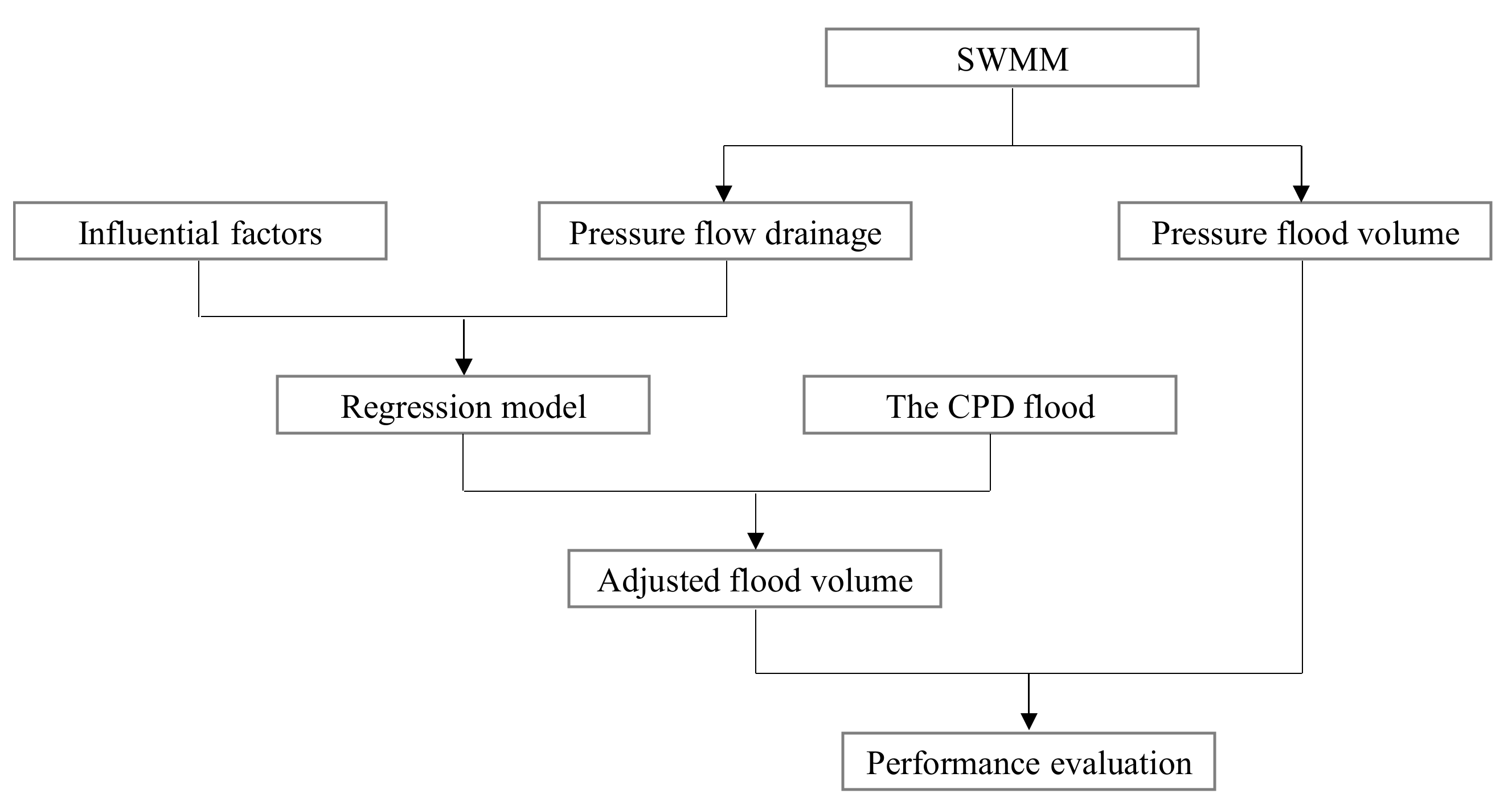
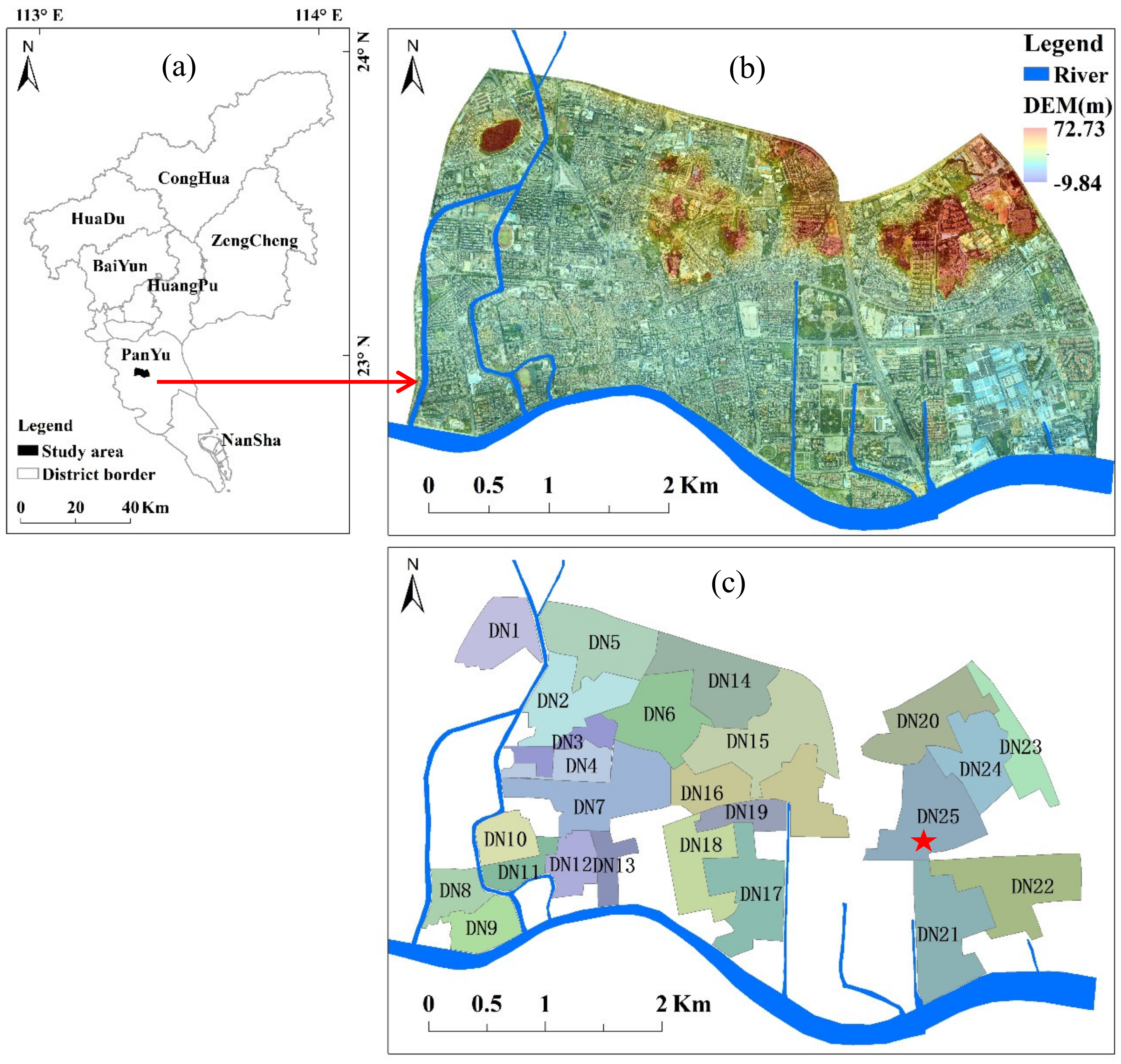
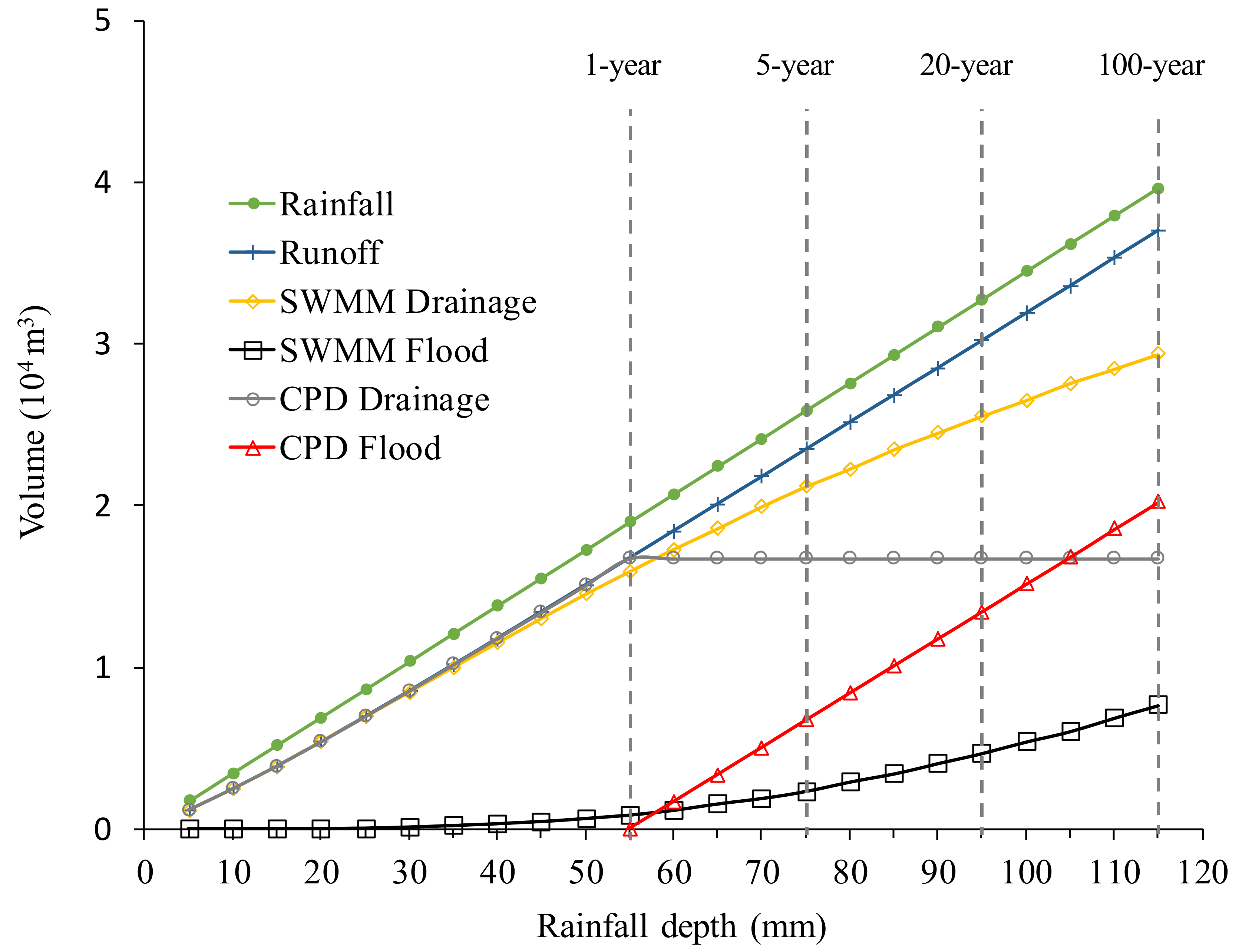
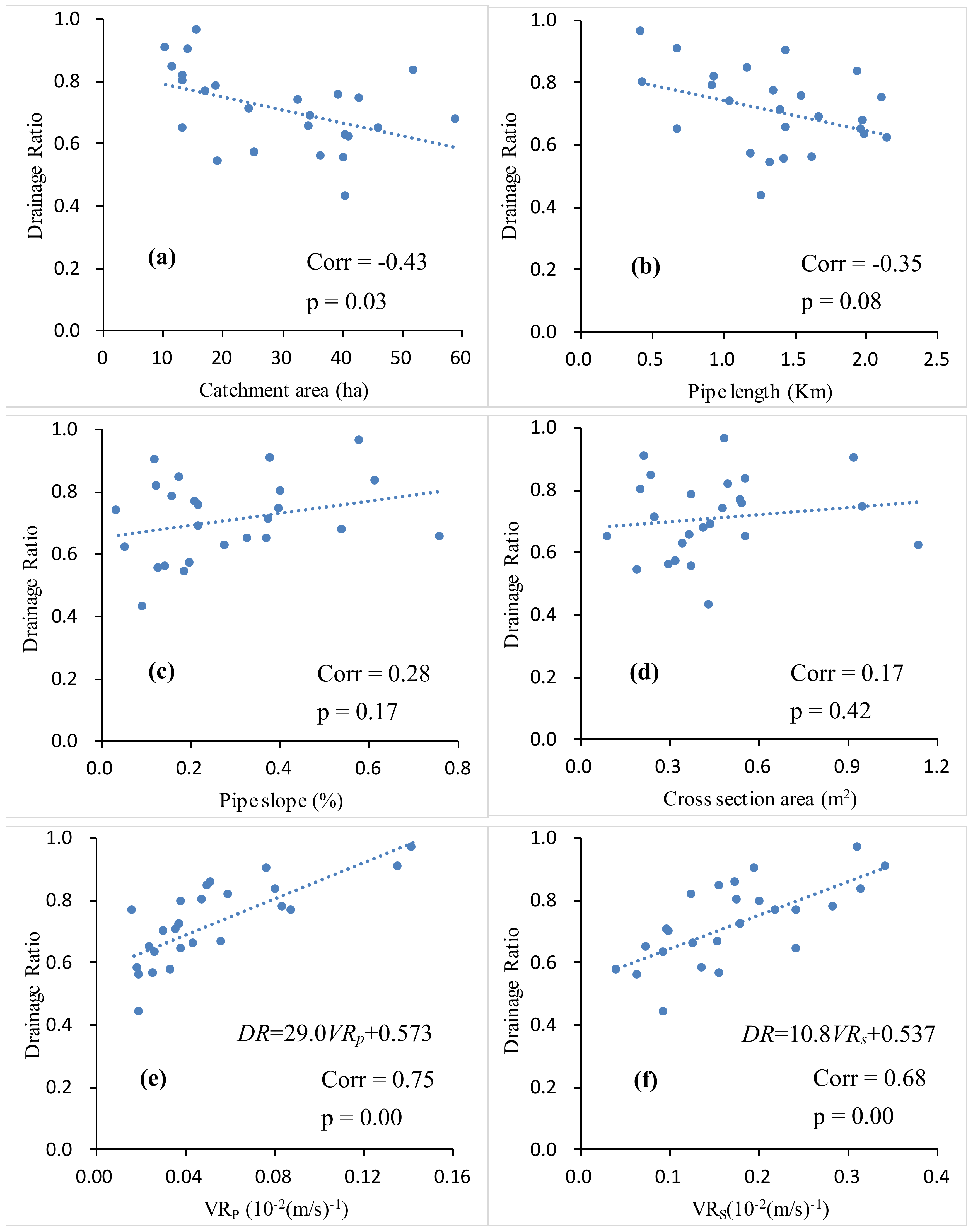

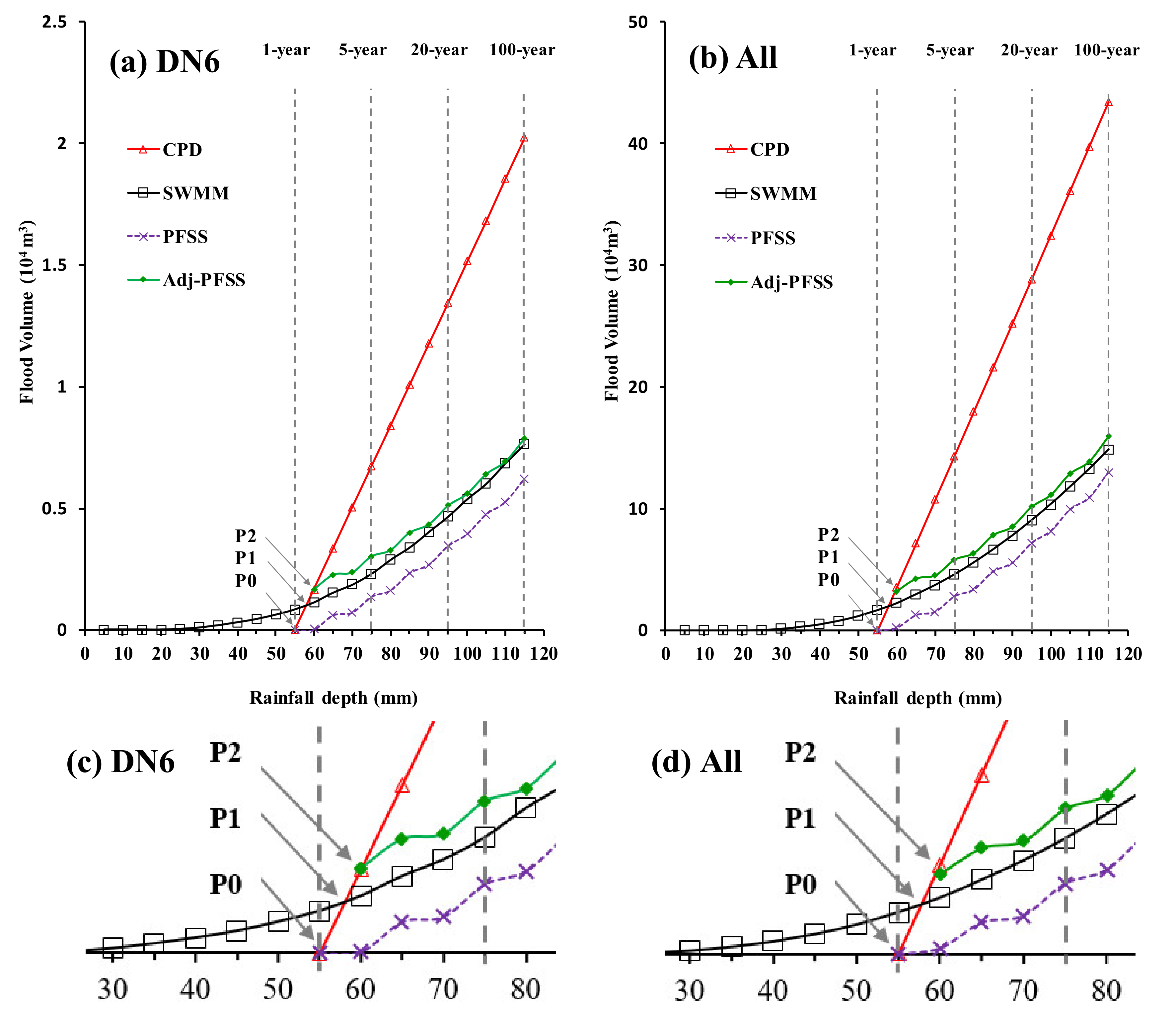
| Return Period (Year) | Average Intensity (L/(ha.s)) | Rainfall Depth (mm) |
|---|---|---|
| 1 | 151.3 | 55 |
| 2 | 176.1 | 63 |
| 5 | 209.7 | 76 |
| 10 | 236.2 | 85 |
| 20 | 263.6 | 95 |
| 50 | 295.1 | 106 |
| 100 | 315.5 | 114 |
| Network | Min | Max | Network | Min | Max |
|---|---|---|---|---|---|
| DN1 | 0.72 | 0.93 | DN14 | 0.77 | 0.84 |
| DN2 | 0.70 | 0.88 | DN15 | 0.70 | 0.85 |
| DN3 | 0.84 | 0.93 | DN16 | 0.84 | 0.94 |
| DN4 | 0.89 | 1.00 | DN17 | 0.55 | 0.67 |
| DN5 | 0.63 | 0.79 | DN18 | 0.57 | 0.74 |
| DN6 | 0.66 | 0.82 | DN19 | 0.76 | 0.88 |
| DN7 | 0.67 | 0.88 | DN20 | 0.58 | 0.76 |
| DN8 | 0.85 | 0.97 | DN21 | 0.44 | 0.60 |
| DN9 | 0.80 | 0.94 | DN22 | 0.64 | 0.79 |
| DN10 | 0.82 | 0.97 | DN23 | 0.56 | 0.75 |
| DN11 | 0.65 | 0.78 | DN24 | 0.75 | 0.93 |
| DN12 | 0.96 | 1.00 | DN25 | 0.79 | 0.88 |
| DN13 | 0.90 | 0.99 |
| Return Period | Catchment Area | Pipe Length | Pipe Slope | Pipe Cross Section Area | VRp | VRs |
|---|---|---|---|---|---|---|
| (Year) | (ha) | (km) | (%) | (m2) | ((m/s)−1) | |
| 2 | −0.48 * | −0.37 # | 0.23 | 0.08 | 0.68 * | 0.64 * |
| 5 | −0.47 * | −0.36 # | 0.28 | 0.11 | 0.72 * | 0.65 * |
| 10 | −0.44 * | −0.33 # | 0.29 | 0.15 | 0.75 * | 0.68 * |
| 20 | −0.43 * | −0.34 # | 0.29 | 0.15 | 0.74 * | 0.68 * |
| 50 | −0.43 * | −0.35 # | 0.29 | 0.15 | 0.75 * | 0.68 * |
| 100 | −0.43 * | −0.35 # | 0.28 | 0.17 | 0.75 * | 0.68 * |
| Average | −0.45 * | −0.35 # | 0.28 | 0.13 | 0.73 * | 0.67 * |
| Return Period | Regression Equation | Calibration | Validation | |
|---|---|---|---|---|
| R2 | R2 | MAD | ||
| 2 year | DR = 1.795VRs + 0.655 | 0.498 | 0.217 | 0.081 |
| 5 year | DR = 3.837VRs + 0.614 | 0.506 | 0.239 | 0.087 |
| 10 year | DR = 6.008VRs + 0.578 | 0.519 | 0.299 | 0.089 |
| 20 year | DR = 8.382VRs + 0.544 | 0.519 | 0.324 | 0.091 |
| 50 year | DR = 10.506VRs + 0.513 | 0.513 | 0.329 | 0.093 |
| 100 year | DR = 13.253VRs + 0.488 | 0.527 | 0.369 | 0.093 |
| DN6 | All Networks | |||
|---|---|---|---|---|
| MAD | MRD | MAD | MRD | |
| CPD | 0.70 | 166% | 15.69 | 192% |
| PFSS | 0.12 | 40% | 2.01 | 36% |
| Adj-PFSS | 0.04 | 18% | 0.97 | 18% |
© 2020 by the authors. Licensee MDPI, Basel, Switzerland. This article is an open access article distributed under the terms and conditions of the Creative Commons Attribution (CC BY) license (http://creativecommons.org/licenses/by/4.0/).
Share and Cite
Huang, H.; Pan, Y.; Wang, X. A Simplified Representation of Pressure Flow from Surface Slopes in Urban Sewer Systems. Water 2020, 12, 2778. https://doi.org/10.3390/w12102778
Huang H, Pan Y, Wang X. A Simplified Representation of Pressure Flow from Surface Slopes in Urban Sewer Systems. Water. 2020; 12(10):2778. https://doi.org/10.3390/w12102778
Chicago/Turabian StyleHuang, Huabing, Yu Pan, and Xianwei Wang. 2020. "A Simplified Representation of Pressure Flow from Surface Slopes in Urban Sewer Systems" Water 12, no. 10: 2778. https://doi.org/10.3390/w12102778
APA StyleHuang, H., Pan, Y., & Wang, X. (2020). A Simplified Representation of Pressure Flow from Surface Slopes in Urban Sewer Systems. Water, 12(10), 2778. https://doi.org/10.3390/w12102778







